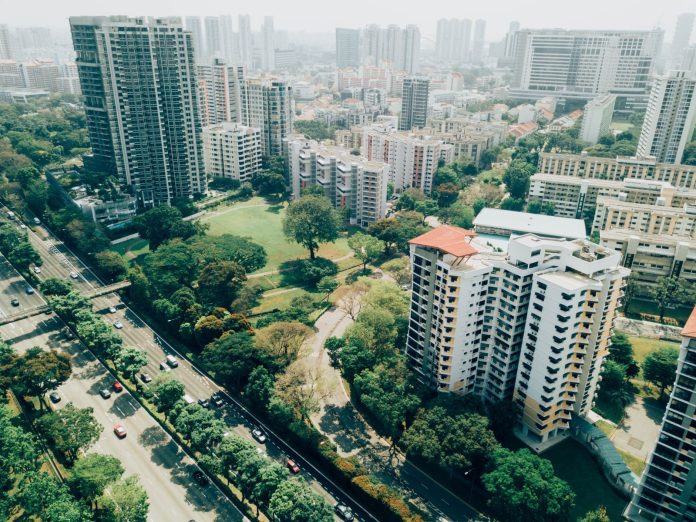We’re seeing homes and lives being destroyed as over five million acres burn between Northern California and Oregon by deadly wildfires. At the same time, states along the Gulf Coast are being hammered with flooding and winds that leave people without power for months as parts of the energy infrastructure is being rebuilt from scratch with no alternatives to support residents in the meantime. As dangerous storms increase in frequency, forecasters have run short on names and transitioned to the Greek Alphabet. We’ve exceeded the average of 12 storms per season to 22 thus far–and the hurricane season isn’t over.
We’re witnessing in real time a total lack of climate resilience across the country: we didn’t plan for the extreme impacts of climate change we are now facing as cities flood and burn beyond the point of containment much longer than anticipated. Meanwhile, the hyper-political association with the term “climate change” continues to thwart the immediate actions we could be taking to protect us from a deadly worldwide crisis that is robbing us of our financial and personal well-being. But we have to start planning for climate change now, whether politicians are ready to take action or not.
While political leaders will always have a hand in national solutions and community development, city planners and urban developers are key to designing spaces that can protect what we’ve already created while re-envisioning how a climate-resilient city looks and functions in the future. Planners and developers facilitate almost every addition to or removal from a city’s infrastructure in advance, and they’re crucial allies in this fight.
Co-designed urban planning can help us discover innovative solutions that work. We may not have all the answers right now, but Denver and Dallas are just a few of the U.S. cities that are getting smarter about planning. As these large cities keep growing, they’re reducing air pollution from driving by creating more efficient public transportation systems that give more options to residents while improving the flow of traffic to enhance public safety.
If more cities followed suit with similar initiatives, we could find ourselves in a world that embraces technology for faster solutions to fight climate change by reducing greenhouse gas emissions. Through citizen and local government participation, comprehensive solutions that improve existing city structures most vulnerable to flooding, fires, or other climate impacts could also be better implemented.
Imagine cities across the globe where everyone has equal access to local jobs and critical services. Citizens are aware and involved with the design of their city infrastructure, and city departments are fully transparent as they make decisions. There would be a shared sense of trust, improved health, and greater opportunity for a more balanced economy that doesn’t contribute to such severe environmental pollution and destruction.
It might look a little like Columbus, Ohio, which won $50 million from the Department of Transportation’s Smart City Challenge for its efforts to bring these characteristics to life in 2016. City leaders in Columbus are leveraging data and technology to address the critical need to provide transportation access to better support communities in need, such as Linden, a neighborhood well-known for its infant mortality crisis.
Tapping into the economic power of being an attractive destination for tourism, city leads also plan to use smart technology to increase convenience for tourists navigating the city, and Ohio Senator Sherrod Brown openly expressed his excitement to collaborate with local leaders and community members to successfully connect neighborhoods in a more sustainable way.
With more than two-thirds of energy consumption and 70% of CO2 emissions coming from cities, collaboration between communities and city planners for climate action is a topic that continues to be broached, but it seems to keep getting lost in the fray of worsening climate disasters and political drama.
But if more collaborators come to the city table to work with the environment instead of against it, what will be the roles of community members that have been most ignored and impacted over time?
A truly smart, co-designed city will look beyond general infrastructure to examine how every city in America has been constructed under historical guidelines that excluded and oppressed marginalized communities, and climate justice would be essential to the collaborative process.
Funding for smarter city planning could be directed towards improving insulation and indoor utility usage to lower bills and save money for residents in economically disadvantaged neighborhoods. Community input could make city planners more likely to create safer and shorter walking distances to public transportation and add bike infrastructure because they’d be more cognizant of the safety risks pedestrians and bicyclists face and the potential conflicts strategies like adaptive traffic signals can create. We can’t only plan for cars; we also need keep people who can’t afford a car front of mind.
In fact, major cities under innovative leadership are already moving forward with equity and climate justice as part of sustainable city design plans.
National solutions are critical as well, but there is an understandable disconnect in comparison to solutions on a city level because city dwellers understand the irreplicable cultures that define our cities in a deeper way. Urban spaces will undoubtedly expand as the global population increases, but local residents can advocate for safer, smarter cities by closely collaborating with city planners to integrate climate change as an unavoidable element of urban designing from beginning to end.
We cannot change the past, but creating more equitable, thriving cities means that silenced communities will become key decision-makers for climate-smart city initiatives. Everyone can benefit from the wisdom of underrepresented voices, because unlike most people in power with greater financial flexibility, underserved communities have been working in harmony with nature’s resources all along because they had no other choice.
The truth is that politicians don’t hold sole power to address the climate crisis. If we begin to create and implement sustainable action plans alongside our neighbors, we have a better chance at survival. As the Yale Program on Climate Change Communication found, more Americans believe in climate change than you might think. That means we already have enough momentum to shift the climate mitigation and adaptation power to local communities because they are the experts on local climate concerns and solutions.
If we create systems of shared power when city planning, and accept that the loudest voices in the room don’t get to decide what’s best for everyone, we won’t fail. Local planning leaders don’t even have to call it “climate change” and we can show politicians how to get it right, all while leaving our personal politics at home.

Princella Talley (Guest Contributor)
Princella Talley is a Public Voices fellow of the OpEd Project and the Yale Program on Climate Change Communication. Princella is an Outreach Coordinator and Development Associate with Citizens’ Climate Education.


